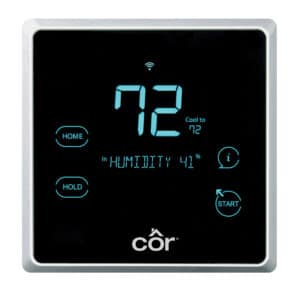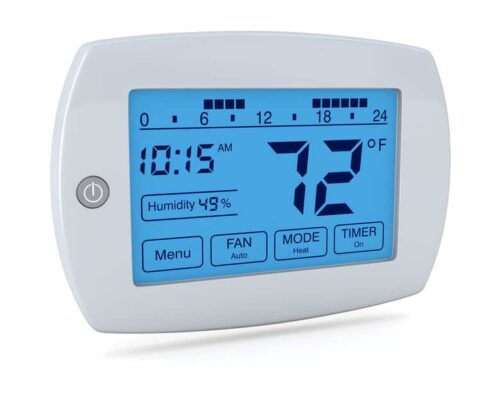Is there a perfect temperature to set your thermostat at for the Summer in order to save energy and still be comfortable? Well, yes, but it varies for each homeowner or business owner. There are recommendations out there by respected organizations that we will discuss in this post, along with some helpful formulas. After reading this post, you will have a better idea of what temperature you should set your thermostat at for the savings you desire.
Let’s get started!
In our last post, we discussed how turning off your air conditioner when you’re away does actually save energy. We also pointed out that turning up the thermostat 7-10 degrees (at least) is the better option when away, in our opinion. But, we didn’t really go over the preferred thermostat setting for Summer months in order to experience true energy (and money) savings.
Well, that’s what we’re going to focus on here.
So, What is the Best Temperature to Set Your Thermostat at for Summer?
According to the Department of Energy, setting your thermostat to at least 78 degrees Fahrenheit (26 degrees Celsius) is the optimal starting point for effective energy savings. Now, that is their recommendation, but it’s not etched in stone as the only temperature to provide savings. It is believed that just by raising your set temperature 1 degree can provide a savings of 1-3%. That means if you raise your thermostat from 72 degrees to 76 degrees as your default set temperature, you can save up to 12% on your energy bill! The more you raise the temperature, the more savings you can expect.
When you’re away, you can raise the temperature even more for optimal savings. Raising the temperature at least 7-10 degrees is recommended when away to truly experience savings.
A Factor to Consider
Now that I’ve shared some recommendations with you, let’s get into an important factor to consider when deciding what temperature to set your thermostat at for the hotter months.
Make sure that you and/or your family or coworkers (if it’s a business environment) are comfortable with the temperature. If you are willing to suffer with being hotter than what is comfortable in order to save energy, then that is fine. Just make sure everyone else is on board as well. It might be wise to try out the temperature that first comes to mind. See if you are comfortable with it. See if everyone else is comfortable with it. If it’s a go, then go for it! You might even consider raising the temperature up another degree or two and see if that is doable. Remember, the higher the temperature, the more the savings.
Some More Energy Saving Tips
Below are some extra tips that will help increase energy savings in conjunction with raising the thermostat’s temperature.
1) Make Use of Fans!
According to the Department of Energy, using a fan can hide the effects of raising the temperature 4 degrees Fahrenheit. That means that it’s possible to raise the temperature 4 degrees and not even notice it with the use of a ceiling fan! When you’re not in the room, you can turn the fan off. Fans don’t cool rooms, they simply provide a wind chill effect to those in the room.
2) Keep Out Excess Heat
Use window treatments and coverings to keep excess heat from entering your home or business. If the sun is blazing through your windows, you can be sure it is increasing the temperature in that area.
3) Control the Humidity That is Indoors
We can’t control the humidity level outside, but we can inside. This is especially important for those of us who live in the South or in coastal areas that are naturally high in humidity. When the humidity level is higher, it feels much hotter than it actually is temperature wise.
A typical air conditioner does remove humidity naturally, but sometimes that is not enough. In areas with high humidity, a dehumidifier might be needed. There are actually dehumidifiers that can be used in conjunction with your heating and air system. There are also thermostats that actually have a built-in humidity control feature that communicates with the air conditioner to further control the humidity level.
4) Upgrade Your Thermostat
Without a programmable thermostat, you will be required to turn up the temperature and turn it back down whenever you want to adjust it. For example, when you’re away, you’ll have to turn up the thermostat before you leave and turn it back down once you get back.

With a programmable thermostat, the thermostat can be programmed to automatically raise and lower the temperature whenever you schedule it to do so. Smart thermostats can do the same, but they can be accessed with any device that uses internet to adjust the temperature anytime, anywhere.
5) Keep Up With Routine Maintenance
Neglecting proper maintenance of your cooling system can cause the system to operate inefficiently and even lead to major breakdowns and repairs. For example, a dirty or clogged air filter will hinder air flow into your home which will cause the system to have to run longer to cool the home to the set temperature. This can also lead to issues with expensive components, such as the compressor. Avoid this by having your local HVAC technician provide preventive maintenance for your heating and air unit(s) on a regular basis.
Next Steps
Experiment, find your “perfect” temperature, and rake in the savings!
Have you already put these practices to work? What temperature do you set your thermostat at for the Summer? How much savings have you experienced?
We’d love to hear your answers! Leave a comment below!



